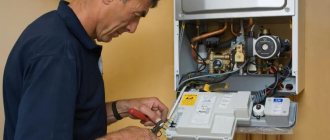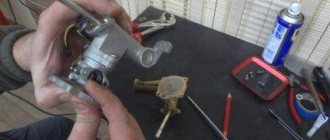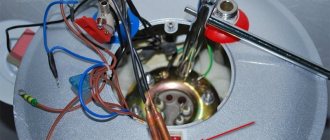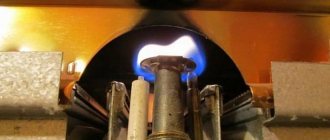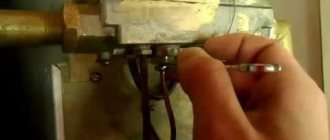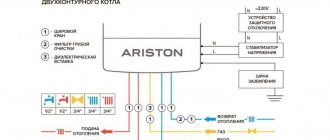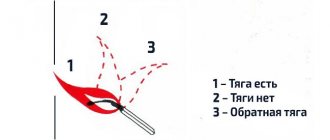In houses with a centralized gas supply, there is often no hot water supply. That’s why a gas water heater is often used there. As opposed to a boiler, it provides intensive heating of running water, while at the same time not limiting users in its volume. The design of such a water heater is quite simple, operation does not require special conditions. But sometimes during operation of the unit heating problems arise. To avoid them, you should familiarize yourself with the design of heating equipment and study the most common causes of breakdowns.
If the geyser is in poor technical condition, it will not be able to provide good pressure and the required water temperature Source tehnofaq.ru
Principle of operation
The method of operation of an instantaneous gas water heater is as follows:
- The gas burns and heat is released.
- The heat exchanger heats up and transfers thermal energy to the water.
- The heated water flow is directed into the pipeline.
- Combustion products exit through the chimney.
A typical column consists of the following elements:
- Frame. Made from heat-resistant metal alloys, it hides parts. Some water heater models include an electronic display that helps you monitor the operation of the equipment. If the device breaks down, a warning signal appears on the screen.
- Thermostat. Maintains constant water temperature.
- Heat exchanger. This is the main heating element.
- Gas valve. When the valve is turned on, it provides fuel supply.
- The combustion chamber. In it, gas is converted into heat.
- Ignition system. It can be mechanical or automatic.
- Battery.
- Gas-burner.
- Smoke exhaust.
- Fan. Accelerates the removal of waste waste.
- Water valves (inlet, outlet).
If a geyser does not heat water well, the root cause often lies in damage to one of the above elements. To normalize the operation of the water heater, it is necessary to repair the damaged part or replace it with a new one.
Descaling the system
The water in Russian pipes has never been of good quality, therefore, during the operation of gas equipment, various salts and metals accumulate on the internal sections of the heat exchanger. In this case, the diameter of the outlets gradually narrows, and the scale layer reduces the thermal output of the entire system.
It turns out that with an acceptable water pressure, the pipes do not heat up sufficiently, and we get a significant decrease in efficiency. But this problem can be dealt with on your own. To clean the radiator from scale, simply rinse it. Depending on the degree of contamination, citric acid is used, and in difficult cases, specialized detergents are used.
Dismantling the geyser heat exchanger
To fully clean the system, it is necessary to remove the radiator from the gas water heater. Washing some individual parts is less effective, but if it is impossible to dismantle the element in principle, then you have to be content with little.
Before dismantling, it is necessary to turn off the column and turn off the gas and water supply taps. You also need to drain all liquid from the system. We release the panel behind which the radiator is located by unscrewing the fasteners and remove it. Carefully remove the heat exchanger, trying not to tilt it, because there is probably water left there.
Cleaning the heat exchanger from scale
The cleaning procedure itself is extremely simple: pour citric acid or a specialized product into the radiator and leave it for a couple of hours in some warm place. During this time, the composition will react with the scale and discharge it. Next, we rinse the heat exchanger with running water and install it in place in the reverse order of disassembly. If necessary, repeat the cleaning procedure.
Major breakdowns
There are many reasons why a gas water heater does not heat water. To understand how to repair a heating unit yourself, if necessary, you need to familiarize yourself with each of the breakdowns and learn effective methods for eliminating it.
Chimney blockage
A smoke exhaust duct heavily clogged with debris cannot provide sufficient draft. If the pipe is poorly permeable, the water heater’s protective system is immediately activated, and the operation of the device is instantly blocked.
You can check the presence of traction in the following way:
- Light a match.
- Bring it to the vent.
- Assess the state of the fire.
If the flame deviates, there is draft; if it burns evenly, there is no draft. This problem is solved by cleaning the chimney, ensuring the unhindered passage of air through the pipe.
A chimney clogged with smoke and soot cannot provide the draft necessary for work, so the water heater’s protective systems stop the gas supply Source terman-s.ru
Ignition system failure
Sometimes when using a water heater, problems with ignition occur. This only applies to automatic devices that operate on batteries. Typically, batteries run out a little earlier than expected according to the instructions.
To understand why the geyser does not heat water after replacing the battery, you should carefully inspect the contacts. If the latter have oxidized, they need to be cleaned, then try to ignite the unit again.
What else can interfere with water heating?
If diagnostics have shown that there are no malfunctions in the operation of the gas heater, but the water heater still does not heat or heats the water poorly, you should listen to the recommendations of professionals.
Among them are the following:
- If the water has always been hot, and then its temperature became insufficient, it is worth checking the gas pressure coming from the pipeline or cylinder. It is not recommended to do this yourself; it is better to call representatives of the gas service.
- The water may remain cool if mixing cold water with hot water is not working correctly You can easily check this by touching the pipe through which water flows from the pump to the tap. If the pipeline is hot and the water coming out of the tap is slightly warm, it is worth repairing the mixer or adjusting its operation.
- When the temperature of the water supplied from the tap changes sharply, the gas heater periodically turns off, it is worth checking the filters in the water heating system and in the mixer.
To increase the temperature of the water leaving the boiler, it is worth opening the gas supply tap as much as possible, and opening the valve responsible for the flow of cold water only halfway. At maximum burner power, the flow of cold water will decrease. This will provide better heating.
Video description
The column does not heat evenly. What to do.
Insufficient water pressure
There are cases when a geyser does not heat water due to false alarms of safety sensors. When the water pressure is excessively weak, the system immediately turns off the device.
How to solve a problem:
- Contact the utility service. There may be a water leak in the pipeline.
- Clean the filters.
- Remove scale from the water heating element.
- Check the membrane.
Sometimes, with minimal water pressure, the gas water heater heats it up too much. This only applies to older models, since they do not have a protection system: in the absence of water, they continue to burn. For safety reasons, it is advisable to replace the outdated device with a modern one.
If cold water flows with the same weak pressure as hot water, the problem of the geyser is a faulty water supply Source cosmo-frost.ru
Burner faults
It happens that the water heater functions, but does not heat the water to the required temperature. This often occurs as a result of poor combustion. Then the liquid simply does not have time to warm up to the required levels. In such situations, the fire in the burner usually smokes and has a specific hue. These signs indicate that the igniter or burner is clogged with soot or soot.
Disassembling the burner device and thoroughly cleaning clogged parts will help get rid of this problem. If there is a gas filter, it should also be checked for clogging.
In columns with piezo ignition, the igniter must burn constantly, because when the hot water tap opens, it must ignite the main burner Source cosmo-frost.ru
Sudden loss of device
If the water does not heat up because the gas water heater goes out immediately or some time after being turned on, the following breakdowns are possible:
- The contact between the magnetic valve and the thermocouple is broken. This occurs due to short circuits that occur when the insulation is damaged. As a result, the device randomly lights up and goes out. This problem is eliminated by replacing the wires.
- Damage to the automatic control system of the water heater. You can detect such a problem after a short observation of the operation of the device. If it functions normally for ten minutes, but then goes out and lights up again, the combustion sensor must be repaired.
Advice! It is better to entrust the repair of electronics of gas equipment to specialists.
Repairing the electronics of a geyser requires certain knowledge and skills, so it is better to entrust it to professionals Source remont57.kh.ua
Water supply blockage
The reason for poor heating of water in a gas water heater may be a clogged water supply. To fix it you need:
- Set the mixer to the third position.
- Fully open the taps and damper.
- Place a container for liquid.
If the above steps do not help, you should contact the utility workers. Old pipes may need to be replaced.
Failure Prevention Measures
To reduce the likelihood of geyser malfunctions and safely enjoy hot water, it is necessary to carry out periodic maintenance. You can do the work yourself or use professional services.
Prevention involves disassembling and thoroughly cleaning the gas water heater. We have provided a detailed description of the manual service process in this material.
Periodic maintenance and cleaning of the chimney will extend the life of the gas water heater.
When carrying out maintenance work, do not forget about the chimney. When the channel for discharging combustion products becomes clogged with soot and foreign objects, the protection is triggered and the water heater is turned off.
For what reasons does fuel burn incompletely?
During the physicochemical process of combustion of saturated hydrocarbons and its subsequent products, carbon dioxide is formed. It happens that there is no fresh air supplied and during the combustion process, in addition to carbon dioxide products, carbon monoxide is formed in the form of pollution and soot. By the way, carbon monoxide exists in all gas burners; this is its usual state. This cannot be avoided. Sometimes, to keep the internal walls of the burners clean, combustion chambers are installed, where the combustion process takes place. In water heaters operating on ducts, such chambers are not used. In order to look at the gas combustion process, you can remove the front panel of the gas burner and look at the inside of the device.
Sometimes the panels are dirty and smeared with soot. To clean them, ensure the flow of air into the chamber and clean the device. For one cubic meter of gas to burn properly, it will require about ten parts of fresh air. In devices designed to generate gas, everything is provided in advance; with the help of a specially installed air valve, free access of fresh air into the chamber can be ensured.
Remember that you should not neglect cleaning the heat exchanger panels, because this could result in poor water heating and excessive fuel consumption.
Checking the functionality of electrical elements
First, you should check the functionality of the hot water valve, and then see if the boiler on indicator light works.
If the light does not light and the water heater has stopped heating water, then the sequence of actions is as follows:
- The boiler is de-energized, emptied of water, and the housing cover is removed.
- At the ends of the thermostat you need to check the presence of incoming current. For this, it is advisable to use a special tester, and not an indicator, to prevent a break in the supply “zero”;
- If voltage is supplied, then you need to press the thermal protection button. Did it ensure inclusion? Now preventive cleaning of the heating element from scale will be required - it has overheated.
- The thermal protection could also work due to the fact that hot water does not flow out of the tank due to a broken safety valve. Please note that the valve can only be replaced with a standard one - it is not recommended to install a regular check valve here.
- You need to remove the thermostat and ring it. If it doesn't turn on, it needs replacement. Repairing a thermostat is problematic - in most cases there are no mechanical elements.
conclusions
If it happens that the gas water heater malfunctions and begins to heat the incoming water poorly, you should pay attention to its internal walls - perhaps contaminants in the form of dirt and scale have accumulated there. Such deposits can be easily removed yourself and your equipment will definitely return to its original condition.
Sources
- https://seositi.ru/otoplenie/kotly/gazovaya-kolonka-ploxo-greet-vodu.html
- https://tehnika.expert/klimaticheskaya/gazovaya-kolonka/pochemu-ne-greet-vodu.html
- https://sovet-ingenera.com/otoplenie/vodonagrevatel/pochemu-gazovaya-kolonka-ne-greet-vodu.html
- https://tehnofaq.ru/pochemu-voda-v-gazovoj-kolonke-ne-nagrevaetsya/
- https://oteple.com/prichiny-pochemu-gazovaya-kolonka-ne-greet-vodu/
- https://cosmo-frost.ru/gazovye-kolonki-i-kotly/neispravnosti-gazovye-kolonki-i-kotly/pochemu-gazovaya-kolonka-ploxo-greet-sovsem-ne-greet-vodu/
- https://www.o-vannoy.ru/gazovye-kolonki/ne-greet-vodu/
- https://eurosantehnik.ru/ploxo-greet-gazovaya-kolonka.html
Why is the water from the tap sometimes hot and sometimes cold?
The reasons for failures in flow-through and storage gas water heating equipment are different. In the latter case, the malfunctions are directly related not to the water heater itself, but to the water supply system, more precisely to the mixer taps. Depending on the type of column, the following faults are diagnosed:
- Flow column - if either hot or cold water comes out of the column, the problem lies in the pressure in the pipeline. Pressure surges are reflected in the heating intensity of the liquid. When the water pressure is low, the column turns off, then turns on again, which leads to a change in heating. Even in water heaters with a modulating burner, changes will be noticeable and will affect the comfort of water procedures. The problem can be solved by installing a booster pump for cold water. After installation, low water pressure will not affect the operation of the water heater.
- Storage boiler - the operating principle differs from a flow-through gas water heater. The water is heated to the required temperature in the tank and the hot water supply has a stable temperature. Temperature changes are associated with rubber gaskets on the rotary valves. The water heater brings the water temperature to 60-90°C. Rubber gaskets expand due to heat, and the duct narrows. When mixing hot and cold water, the consumer will inevitably encounter temperature changes. A way out of the situation: replace the mixer taps with semi-rotary ceramic taps.
Constant changes in water heating temperature are no longer associated with malfunctions of the water heater, but with the characteristics of the cold water supply and the peculiarities of the operation of storage equipment.
Fixing a leak in a gas water heater
This problem is relevant both for new equipment and for old gas boilers that have been operating for several years. The column can leak for a number of different reasons, but the main ones are the following:
- incorrect connection of water hoses;
- absence or wear of gaskets at joints;
- A fistula has formed in the radiator tube.
There are no problems with the first two cases: we go through and reconnect the hoses, not forgetting to lay the seals.
Experts recommend using silicone gaskets, especially for gas equipment. They provide decent tightness and last much longer than ordinary rubber or tow.
As for the fistula, you can try to solder it, but this is only a temporary solution. If the material begins to deteriorate and crack in one place, it means that soon the entire radiator will be covered in such fistulas. Therefore, the only correct option is to completely replace the heat exchanger.
Sealed geyser
Reasons why the water assembly rod may jam
If the rod on the water unit is in a state of malfunction, then there is no need to panic in such cases - make sure that when using a hot water tap, the flame will not increase with renewed vigor. If fuel combustion occurs intermittently, inconsistently, then try to change the water temperature in case of poor heating.
The malfunction of the unit rod can be eliminated independently and without calling a team of workers. You will need basic tools before repairing: a wrench, screwdrivers with different bits and a Phillips slot.
First aid
Before looking for a breakdown and calling a repairman, check that all conditions for normal operation of the column are met.
What to look for:
- If the water is not hot enough, check the temperature regulator and, if necessary, turn it to the desired value;
- If the device is working at maximum, the pressure is very good, but you need to make the water hotter, open the tap halfway;
- Check whether the gas tap is fully open, especially if you recently turned off the gas due to repairs or departure;
- If the dispenser operates on liquid gas, call a technician to inspect the cylinder and check its serviceability;
- Check to see if the cold water is turned on anywhere;
- Compare the temperature of the hose at the dispenser and the mixer. If it is different, the tap needs to be cleaned;
- Check if the filters are clogged.
If all of the above is working properly, but the water heating system still does not work well, you need to look for a breakdown in the device itself.
What to do if the column stops heating
If the water is too cool, turn the temperature control on the dispenser all the way to the right. Open the water tap halfway to slow down the flow through the column - this will help heat the water more.
The gas pressure on the burner may be too low. Make sure the valve on the gas line is open. If you use liquefied propane gas, invite a technician to inspect the gas pressure regulator installed on a steel cylinder.
Check the faucet for cold water. Grab the outlet hose with your hand and hold the mixer in the tap with your other hand and compare the temperature. If there is a difference in temperature, you should most likely change the mixer.
If the water temperature fluctuates and the geyser turns off. Make sure that all faucets in the house and shower heads are not clogged with mineral deposits or rust. You should also remember to promptly clean the filter elements (mesh) installed in front of the column.
See also:
|
